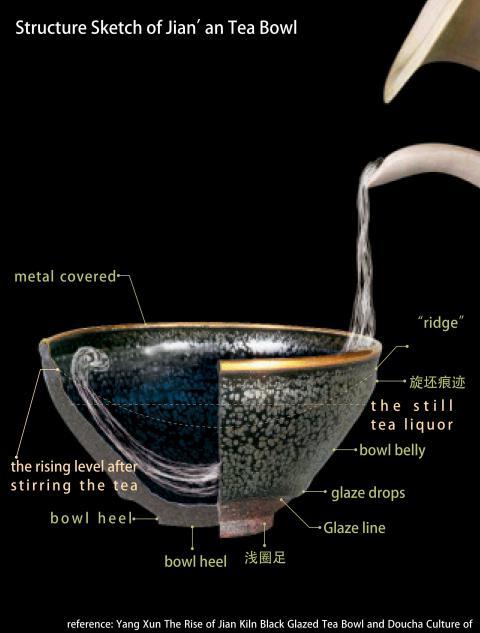The Song Dynasty: The Tea Wars (960 - 1279)
Because tea was an indicator of rank and social status, people devised a more objective way to determine who was the most cultured. These competitions also served ass an indiction of which tea was higher quality. Thus the so-called "tea wars" were created. There were at least two competitions: who has the whitest tea powder and whose tea foam could last the longest. Jian ware bowls were often painted with a dark glaze to better emphasize the whiteness of the tea foam(China Scenic). They were also structured to better support the foam. The appreciation for lighter or white foam may stem from Lu's writings on tea. He posits that dark tea is lesser quality than teas that are a lighter yellow/green color (Tea Sutra 37).
To create foam, the Chinese used a whisk. They developed techniques to whisk gently and pour in the water gradually to thus create the best foam. On the bottom of the bowl, there is a small ridge and the Song realized that when the water is poured down the inside wall of the bowl, it "shoots" over the ridge causing good bubbles to form. The glaze on the bowl is to keep the water hot and help the foam last (Cherry Hill). Another distinctive feature of these bowls is the “hare’s fur” design that result from varying kiln temperatures. This, along with the “iridescence” of the glaze serve to indicate the bowl’s era. The more iridescent the bowl, the older it is.
Tea competitions are a tradition that still takes place today. These events brought communities together and resulted in tea becoming a drink for everyone not appreciate, not just the elite. Anyone can attend the "fights" and help decide which tea is the best (Verdant Tea).
It also was during this dynasty that the Japanese really began to learn about and embrace Chinese tea culture (Verdant Tea). These bowls served as a form of diplomacy between China and Japan. The Japanese appreciated the craftsmanship of the bowls. These bowls have been found in wrecks off the coast of Japan that have been dated to the early fourteenth century (China Heritage Quarterly).


